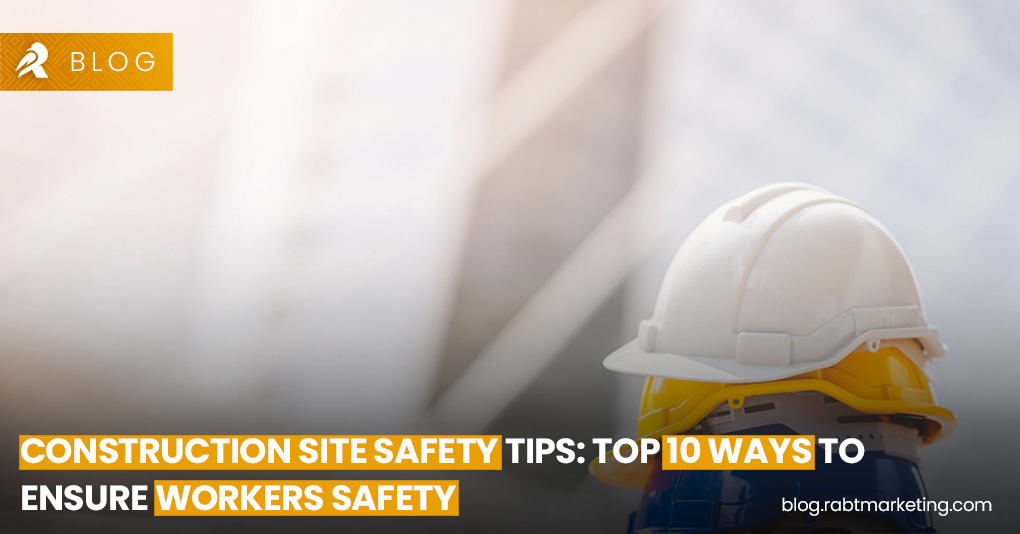Site safety is a very important concern in the construction industry. Because of complex processes and heavy machinery, construction is a difficult task, and sometimes human lives are at stake because construction inherently involves hazards like working at heights, using heavy machinery, and being exposed to elements. Construction site safety refers to the practices and procedures that are used to prevent accidents, injuries, and illnesses among workers.
This article was written to educate project managers and industry leaders regarding top safety tips and tricks for civil engineers and construction industry engineers.
Top 10 Safety Tips for Construction Sites

The following are some important safety tips for construction sites that construction managers must follow for the safety of their team.
1. Conduct Regular Safety Training
Regular and comprehensive site safety training sessions before the commencement of any project can drastically reduce accidents. Training should address the specific risks associated with the construction project and reinforce general safety principles.
2. Wear Appropriate Personal Protective Equipment (PPE)
Mandatory use of appropriate personal protective equipment (PPE) such as hard hats, safety goggles, gloves, and high-visibility clothing is crucial. Ensure that all workers are equipped with the necessary PPE tailored to their task.
3. Implement Strict Access Controls
Limiting site access to authorized personnel helps minimize accidental injuries to visitors or passersby. Employ signage and fencing to secure the perimeter and control access points.
4. Maintain a Clean and Organized Site
A clutter-free and well-organized construction site reduces the risk of trips and falls — common accidents in construction areas. Regular cleanup routines can help maintain order and safety.
5. Use Correct Tools and Equipment
Always use the right tools for the job and ensure that equipment is regularly inspected and maintained. Faulty equipment is a significant hazard and must be promptly repaired or replaced.
6. Provide Clear Signage and Warnings
Use clear and visible signs to warn about specific hazards, like wet floors, overhead loads, or electrical risks. This not only alerts workers but also enhances overall situational awareness.
7. Enforce Load Management Protocols
Overloading equipment or improper stacking of materials can lead to collapses and accidents. Adhering to load limits and proper material storage techniques is essential for site safety.
8. Implement Fall Protection Systems
Weak fall systems are one of the top causes of death in construction. Always use adequate fall protection systems such as guardrails, safety nets, or personal fall arrest systems when working at height.
9. Develop and Practice Emergency Responses
Prepare for emergencies by establishing and routinely practicing emergency procedures. This includes drills for evacuations, medical emergencies, and fire outbreaks.
10. Encourage Reporting and Open Communication
The environment must be very safe where. Workers feel safe to report unsafe conditions or near misses. This not only prevents accidents but also fosters a culture of safety.
Read More:- Roles and Key Responsibilities of Construction Managers
Read More:- Roles and Key Responsibilities of Quantity Surveyor in Construction Industry 2024
FAQ’s
Q1: How often should site safety training be conducted during a construction project ?
A: Safety training should be conducted regularly, especially when new hazards are introduced or when new workers join the site. It’s also wise to have brief daily safety discussions to reinforce protocols.
Q2: What are the most common injuries at construction sites?
A: The most common injuries include falls, being struck by an object, electrocutions, and caught-in/between accidents, collectively known as the “Fatal Four” by OSHA.
Q3: Is it necessary to have a dedicated safety manager on each construction site?
A: While only sometimes mandated, having a dedicated safety manager on site is best practice to ensure continuous monitoring and management of safety policies.
Q4: How can I ensure that temporary workers follow the same safety procedures as permanent staff?
A: Incorporate universal safety inductions and ensure all workers, regardless of their contract length, understand and commit to the site’s safety requirements.
Q5: What should be included in a construction site safety plan?
A: A comprehensive safety plan includes identified risks, safety protocol, emergency procedures, training schedules, safety equipment requirements, and compliance checks.
Q6: Can the use of technology enhance construction site safety?
A: Absolutely! Modern technologies like drones for site surveying, wearable tech for monitoring workers’ health, and software for real-time communication can significantly enhance safety.
Final Thoughts
Ensuring site safety on a construction project require dedication and persistent effort from everyone involved. By integrating rigorous training, proper equipment usage, and proactive hazard management into daily operations, construction sites can maintain high safety standards. Each safety tip mentioned here not only helps reduce the risk of accidents but also fosters a culture where safety is deeply embedded in every activity. Remember, a safe construction site is the bedrock on which successful projects are built. Stay safe, stay aware!

